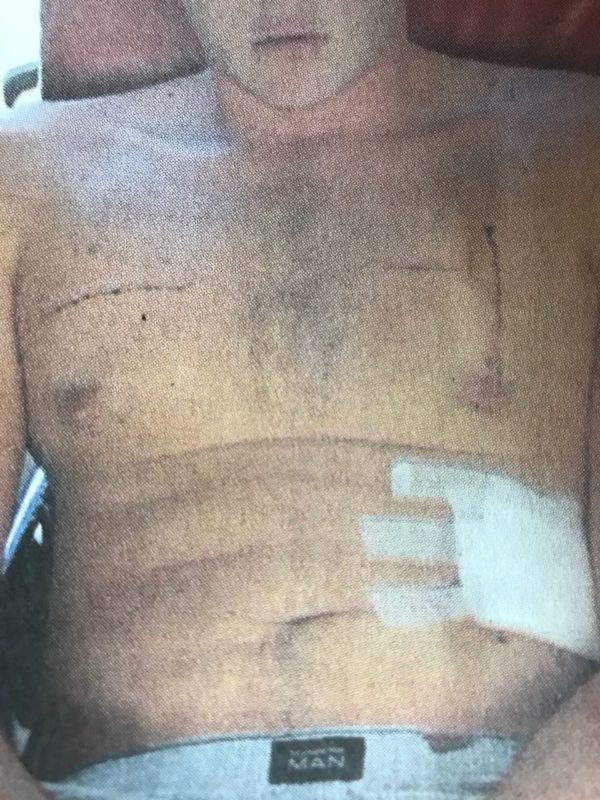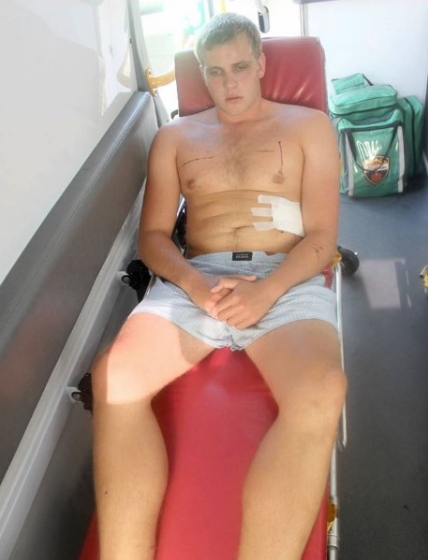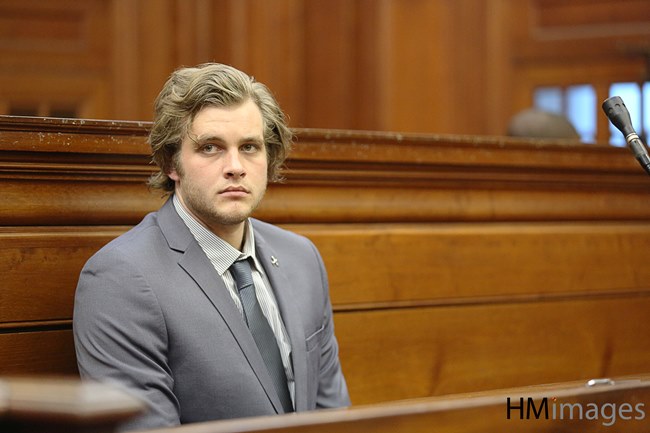Day 16 of the van Breda murder trial saw a continuation of the evidence presented last week by Dr. Tiemensma, a forensic pathologist lead by the state.
Dr. Tiemensma returned to the witness stand today, as per a previous request by the defence, to provide evidence with their pathologist present to hear the evidence being lead. It was a fair request because the defence needed their own expert to hear the evidence.
Attention was brought to Henri’s wounds once again, with Dr. Tiemensma’s conclusion (reported on last week) pointing to his wounds were most likely self-inflicted. How the injuries occurred were an important element for her to consider because defensive type wounds should have been present – but they were not. She testified that it is well accepted in forensic science that defensive wounds are critical evidence of an attack.
The evidence was very well substantiated. Dr. Tiemensma, herself having dealt with in excess of 500 cases, presented a compelling view of how Henri’s plea explanation about how his wounds were inflicted was unlikely, and did so by using multiple fair and reasonable grounds.
STATE GAINING GROUND
Advocate Botha had a very hard time cross-examining Dr. Tiemensma on Day 16. There is no doubt that she has been exposed to plenty of cross-examination in her career – she was exceptionally well prepared; producing immediate, precise and well-substantiated views about anything that was put to her. At one point, she even challenged a quote read out to her by the defence from a forensic science textbook (noted to be the 2nd edition, when Dr. Tiemensma possessed the 3rd edition!). She immediately interjected with a contradictory quote from an article she had with her in court, written by a neurologist, when she dealt the evidence on concussions.
We break for tea, Dr Tiemensma has been an excellent expert witness for the state, she is exceptionally well prepared @CapeTownEtc #vanbreda
— Tracey Stewart (@Traceyams) May 23, 2017
We should keep in mind the Defence’s pathologist and neurologist have yet to testify, but given her solid testimony and the gravitas of her experience, it is my opinion that it is going to be tough for Judge Desai to doubt her conclusions.
Below is the detail of what Dr. Tiemensma told the court during her testimony to explain why, in her expert opinion, Henri van Breda’s plea explanation don’t hold up.
HENRI’S CUT WOUNDS

On his chest and upper forearm
- They were ‘superficial and non-fatal’ – Dr. Tiemensma explained that they only just puncture the skin in this case. There are even parts in one wound where they do not even puncture the skin it is so shallow.
- They were ‘regular’ – this means that the wound is neat, there is no movement in the wound. Defensive wounds in an attack would normally be more jagged and show more movement by the instrument.
- They were of ‘equal depth’ – it is more typical for defensive wounds to vary in depth in some parts. These wounds were inflicted with precision, she said.
- They were of the ‘same origin’ – typical defensive wounds to be inflicted in varying directions and from various origins. The two cuts on his pectorals were of the same origin and direction.
- They were not on sensitive areas – Henri didn’t have wounds in what she called ‘sensitive areas’ like the nipple, the mouth, or the hands. This matches with typical self-inflicted wounds, which are made in areas that aren’t as sensitive as others.
- They were symmetrical and parallel – the wounds were on equal sides of the body and parallel to one another in a straight line. This is not typical in defensive wounds.
- They were found in easily accessed areas – the wounds were all located on areas of Henri’s body he would easily be able to access.
Dr T: The cuts are superficial and non-fatal. incisions are regular, equal breadth, origin and direction @CapeTownEtc #vanbreda
— Tracey Stewart (@Traceyams) May 23, 2017
HENRI’S STAB WOUNDS
Henri’s arm had stab wounds which Dr. Tiemensma concluded were not necessarily self-inflicted. However, given all the circumstances that point to the cut wounds being self-inflicted, she also said they most likely were. First, she pointed out these were on his left forearm – Henri is right-handed. She also stated that they were parallel and grouped together. When Adv. Botha demonstrated to her that they could have happened when Henri held the attacker’s right arm to prevent being stabbed, she said that was unlikely. These cuts were parallel and of equal depth and grouped together closely, she testified, which is unusual as the knife would likely move in and up and not with such precision.
This expert also dealt with the depth of the stab wound in Henri’s abdomen. Adv. Botha told her that another state witness has said that they could have been 50mm deep based on blood on the knife, although Dr. Albertse had measured them as being 10mm deep. Dr. Tiemensma refuted the depth, testifying that the wound did not enter the abdominal cavity and a man of Henri’s size and weight would have a maximum of 40mm of tissue before reaching the abdominal cavity.
The depth of the wound is important for the defence, because Henri has stated in his plea explanation that he had to pull the knife out of his side after the attacker stabbed him and fled. Dr. Tiemensma refuted that too, testifying that a knife which only enters the abdominal tissue would likely only stay stuck inside the person for a few seconds, as there is nothing to stick to if it doesn’t enter tissue. Dr. Tiemensma also supported this reasoning by declaring that there is no bone in this area of the body.

THE ALLEGED ALTERCATION WITH AN INTRUDER
During cross-examination, Dr. Tiemensma provided her detailed perspective on the alleged altercation with an intruder which Henri had described in his plea explanation. She went into detail about whether or not his version affects the conclusions she had made that his wounds were most likely to be self-inflicted.
Dr. Tiemensma’s opinion is that Henri’s version was not consistent with the wounds that he had sustained. She would not concede that the cut wounds could have been inflicted by another person and this was supported by her view on Henri’s plea explanation.
In response to Adv. Botha’s version that the wounds could possibly be inflicted during a fight with the intruder, Dr. Tiemensma told the court that it is usual for advocates (like Botha) to visualize a static confrontation and this is an unrealistic interpretation of what she called ‘a dynamic fight’.
In support of her statement and to a clearly irate Adv Botha, Dr. Tiemensma read out paragraph 31 of Henri’s plea explanation where he describes the altercation, where Henri said there has been pushing, pulling and stepping back and forth as the attacker stabbed and slashed at Henri. He had been holding onto the attacker’s right wrist while the attacker held onto Henri’s right hand – the hand in which Henri had held the axe, with the blade facing toward Henri’s body.
A very interesting point noted by Dr. Tiemensma is that Henri, despite the dynamic altercation, with the axe blade facing towards him, did not have any wounds inflicted by the blade of the axe.
She said in a ‘dynamic fight,’ as how Henri’s plea describes, there is a lot of movement and also resistance, and Henri had stated that both himself and the attacker held onto each other. In this kind of situation, she testified it is unlikely an attacker could have placed precise linear cuts like the ones Henri had sustained.
Dr. Tiemensma isn’t saying that an attacker wouldn’t have slashed Henri, but that in these circumstances with such movement, an attacker wouldn’t have been able to inflict such precise and similar cuts and then manage to get back to almost the same spot to inflict the second wound. Another important factor is that if the attacker had just brutally axed the Van Breda family, and this was now a life and death fight, Henri’s wounds were not consistent with that type of altercation.
When Adv. Botha put it to her that the adrenaline Henri was experiencing may have dulled any pain, he would still move his body to evade injury, and there was no indication of any movement when these wounds were inflicted, there was control. Henri’s wounds were not defensive, she replied.
INJURIES OF THE DECEASED
Dr. Tiemensma compared the injuries Henri had with those of the deceased and his sister, noting that the injuries of his three dead family members and Marli were not inflicted with the same type of intent and force. She found this to be peculiar given that Henri’s version is that there was a physical life-and death fight between Henri and an attacker.
CONCUSSION
Dr. Tiemensma lead evidence on how long one would fall unconscious from a blow to the head. She told the court that with a concussion, Henri would have lost consciousness for only a few minutes. She stated that in 90% of concussions people don’t even lose consciousness. She further concluded that no signs or symptoms of concussion were noted in Dr. Albertse’s (the doctor who first examined Henri) report.
Adv. Botha objected to this evidence as he believed a neurologist should give the evidence, and he should have his expert neurologist in court to hear this evidence. Judge Desai found that Dr. Tiemensma could provide her views and he would allow an adjournment for Adv. Botha to consult if he needed to – we may see Dr. Tiemensma again if the defence’s neurologist differs.
Adv B: My client tried to google emergency services and spelling wasn’t right is that a sign of concussion @CapeTownEtc #vanbreda
— Tracey Stewart (@Traceyams) May 23, 2017
Dr T: no as he was still performing a goal directed activity trying to get hold of emergency services @CapeTownEtc #vanbreda
— Tracey Stewart (@Traceyams) May 23, 2017
THE BLOOD ON THE STEPS
The defence showed Dr. Tiemensma a photograph of the steps in the Van Breda house. This questioning was important for them as they need to support Henri’s plea explanation, in which he claims to have passed out at the top of the stairs.
The defence asked Dr. Tiemensma if she believes it is possible that a very particular spot of blood on the top corner of the top step could have been blood from Henri’s abdominal wound – she was not quick to concede this as being possible. She enquired about which direction Henri’s body had been facing – Adv. Botha didn’t give this detail, telling her that with respect, she needed to answer questions and not ask them.
Dr. Tiemensma concluded that it may be possible but only if he passed out with his abdomen on the stair. She cautioned the court that if the blood was wet at that stage, it would not have looked this way, as it would have dripped down the stairs. She also suggested that the blood smear around the wound, as shown in the photograph she was asked to consider, may have been caused by paramedics.
Adv. Botha reminded her that Henri’s plea outlined that the wound wasn’t cleaned and suggested Dr. Tiemensma was not in a position to dispute this fact. This was an interesting development, as Adv. Botha now either needs to put Henri in the witness box or another paramedic to give that evidence.
In hindsight, during Dr. Tiemensma’s cross-examination, she actually produced more evidence which harmed the defence than she did in her leading, untested evidence.
Dr Tiemensma was an excellent state witness. She did not waver and not intimidated by cross examination. @Traceyams @CapeTownEtc #vanbreda https://t.co/I9Mo1JrL0V
— Les Faber (@LeskaFaber) May 23, 2017
On Day 17 of the van Breda trial, we will hear from a new witness for the state, and I expect it will be more expert evidence. Follow me for live updates from the Cape High Court.
Photography K-Leigh Siebritz / HM Images






